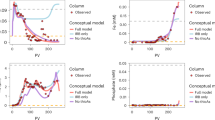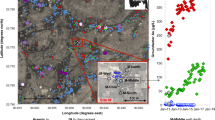Abstract
Groundwater drawn daily from shallow alluvial sands by millions of wells over large areas of south and southeast Asia exposes an estimated population of over a hundred million people to toxic levels of arsenic1. Holocene aquifers are the source of widespread arsenic poisoning across the region2,3. In contrast, Pleistocene sands deposited in this region more than 12,000 years ago mostly do not host groundwater with high levels of arsenic. Pleistocene aquifers are increasingly used as a safe source of drinking water4 and it is therefore important to understand under what conditions low levels of arsenic can be maintained. Here we reconstruct the initial phase of contamination of a Pleistocene aquifer near Hanoi, Vietnam. We demonstrate that changes in groundwater flow conditions and the redox state of the aquifer sands induced by groundwater pumping caused the lateral intrusion of arsenic contamination more than 120 metres from a Holocene aquifer into a previously uncontaminated Pleistocene aquifer. We also find that arsenic adsorbs onto the aquifer sands and that there is a 16–20-fold retardation in the extent of the contamination relative to the reconstructed lateral movement of groundwater over the same period. Our findings suggest that arsenic contamination of Pleistocene aquifers in south and southeast Asia as a consequence of increasing levels of groundwater pumping may have been delayed by the retardation of arsenic transport.
This is a preview of subscription content, access via your institution
Access options
Subscribe to this journal
Receive 51 print issues and online access
$199.00 per year
only $3.90 per issue
Buy this article
- Purchase on Springer Link
- Instant access to full article PDF
Prices may be subject to local taxes which are calculated during checkout



Similar content being viewed by others
References
Ravenscroft, P., Brammer, H. & Richards, K. Arsenic Pollution: A Global Synthesis (RGS-IBG Book Series, Wiley-Blackwell, 2009)
BGS/DPHE. (British Geological Survey, Department of Public Health Engineering) Arsenic Contamination of Groundwater in Bangladesh Final Report, http://www.bgs.ac.uk/arsenic/bangladesh/ (British Geological Survey, 2001)
Fendorf, S., Michael, H. A. & van Geen, A. Spatial and temporal variations of groundwater arsenic in south and southeast Asia. Science 328, 1123–1127 (2010)
Ahmed, M. F. et al. Epidemiology: ensuring safe drinking water in Bangladesh. Science 314, 1687–1688 (2006)
Berg, M. et al. Magnitude of arsenic pollution in the Mekong and Red River deltas—Cambodia and Vietnam. Sci. Total Environ. 372, 413–425 (2007)
Eiche, E. et al. Geochemical processes underlying a sharp contrast in groundwater arsenic concentrations in a village on the Red River delta, Vietnam. Appl. Geochem. 23, 3143–3154 (2008)
Funabiki, A., Haruyama, S., Quy, N. V., Hai, P. V. & Thai, D. H. Holocene delta plain development in the Song Hong (Red River) delta, Vietnam. J. Asian Earth Sci. 30, 518–529 (2007)
Larsen, F. et al. Controlling geological and hydrogeological processes in an arsenic contaminated aquifer on the Red River flood plain, Vietnam. Appl. Geochem. 23, 3099–3115 (2008)
Thu, T. M. & Fredlund, D. G. Modelling subsidence in the Hanoi City area, Vietnam. Can. Geotech. J. 37, 621–637 (2000)
Berg, M. et al. Hydrological and sedimentary controls leading to arsenic contamination of groundwater in the Hanoi area, Vietnam: the impact of iron-arsenic ratios, peat, river bank deposits, and excessive groundwater abstraction. Chem. Geol. 249, 91–112 (2008)
Winkel, L. H. E. et al. Arsenic pollution of groundwater in Vietnam exacerbated by deep aquifer exploitation for more than a century. Proc. Natl Acad. Sci. USA 108, 1246–1251 (2011)
McArthur, J. M. et al. How paleosols influence groundwater flow and arsenic pollution: a model from the Bengal Basin and its worldwide implication. Wat. Resour. Res. 44, W11411 (2008)
Horneman, A. et al. Decoupling of As and Fe release to Bangladesh groundwater under reducing conditions. Part I: evidence from sediment profiles. Geochim. Cosmochim. Acta 68, 3459–3473 (2004)
Postma, D. et al. Groundwater arsenic concentrations in Vietnam controlled by sediment age. Nature Geosci. 5, 656–661 (2012)
Postma, D. et al. Arsenic in groundwater of the Red River floodplain,Vietnam: controlling geochemical processes and reactive transport modeling. Geochim. Cosmochim. Acta 71, 5054–5071 (2007)
Kipfer, R., Aeschbach-Hertig, W., Peeters, F. & Stute, M. Noble gases in lakes and ground waters. Rev. Mineral. Geochem. 47, 615–700 (2002)
Stollenwerk, K. G. et al. Arsenic attenuation by oxidized aquifer sediments in Bangladesh. Sci. Total Environ. 379, 133–150 (2007)
van Geen, A. et al. Flushing history as a hydrogeological control on the regional distribution of arsenic in shallow groundwater of the Bengal Basin. Environ. Sci. Technol. 42, 2283–2288 (2008)
Nath, B. et al. Mobility of arsenic in the sub-surface environment: an integrated hydrogeochemical study and sorption model of the sandy aquifer materials. J. Hydrol. 364, 236–248 (2009)
Itai, T. et al. Variations in the redox state of As and Fe measured by X-ray absorption spectroscopy in aquifers of Bangladesh and their effect on As adsorption. Appl. Geochem. 25, 34–47 (2010)
Radloff, K. A. et al. Arsenic migration to deep groundwater in Bangladesh influenced by adsorption and water demand. Nature Geosci. 4, 793–798 (2011)
Jessen, S. et al. Surface complexation modeling of groundwater arsenic mobility: results of a forced gradient experiment in a Red River flood plain aquifer, Vietnam. Geochim. Cosmochim. Acta 98, 186–201 (2012)
Dhar, R. K. et al. Microbes enhance mobility of arsenic in Pleistocene aquifer sand from Bangladesh. Environ. Sci. Technol. 45, 2648–2654 (2011)
Islam, F. S. et al. Role of metal-reducing bacteria in arsenic release from Bengal delta sediments. Nature 430, 68–71 (2004)
Polizzotto, M. L., Kocar, B. D., Benner, S. B., Sampson, M. & Fendorf, S. Near-surface wetland sediments as a source of arsenic release to ground water in Asia. Nature 454, 505–508 (2008)
Neumann, R. B. et al. Anthropogenic influences on groundwater arsenic concentrations in Bangladesh. Nature Geosci. 3, 46–52 (2010)
Mailloux, B. J. et al. Advection of surface-derived organic carbon fuels microbial reduction in Bangladesh groundwater. Proc. Natl Acad. Sci. USA 110, 5331–5335 (2013)
Mukherjee, A. et al. Elevated arsenic in deeper groundwater of the western Bengal basin, India: extent and controls from regional to local scale. Appl. Geochem. 26, 600–613 (2011)
McArthur, J. M. et al. Migration of As, and 3H-3He ages, in groundwater from West Bengal: implications for monitoring. Water Res. 44, 4171–4185 (2010)
Beyerle, U. et al. A mass spectrometric system for the analysis of noble gases and tritium from water samples. Environ. Sci. Technol. 34, 2042–2050 (2000)
van Geen, A. et al. Comparison of arsenic concentrations in simultaneously-collected groundwater and aquifer particles from Bangladesh, India, Vietnam, and Nepal. Appl. Geochem. 23, 3244–3251 (2008)
Zheng, Y. et al. Geochemical and hydrogeological contrasts between shallow and deeper aquifers in two villages of Araihazar, Bangladesh: implications for deeper aquifers as drinking water sources. Geochim. Cosmochim. Acta 69, 5203–5218 (2005)
Frei, F. Groundwater dynamics and arsenic mobilization near Hanoi (Vietnam) assessed using noble gases and tritium. Diploma thesis, ETH Zurich. (2007)
Klump, S. et al. Groundwater dynamics and arsenic mobilization in Bangladesh assessed using noble gases and tritium. Environ. Sci. Technol. 40, 243–250 (2006)
Stute, M. et al. Hydrological control of As concentrations in Bangladesh groundwater. Wat. Resour. Res. 43, W09417 (2007)
Cheng, Z., Zheng, Y., Mortlock, R. & van Geen, A. Rapid multi-element analysis of groundwater by high-resolution inductively coupled plasma mass spectrometry. Anal. Bioanal. Chem. 379, 512–518 (2004)
van Geen, A. et al. Monitoring 51 deep community wells in Araihazar, Bangladesh, for up to 5 years: implications for arsenic mitigation. J. Environ. Sci. Health A 42, 1729–1740 (2007)
Koroleff, F. In Methods of Seawater Analysis (ed. Grasshoft, K. ) 126–133 (Chemie, 1974)
Acknowledgements
This study was supported by NSF grant EAR 09-11557, the Swiss Agency for Development and Cooperation, grant NAFOSTED 105-09-59-09 to CETASD, and NIEHS grants P42 ES010349 and P42 ES016454. This is Lamont-Doherty Earth Observatory contribution number 7698.
Author information
Authors and Affiliations
Contributions
A.v.G., M.B., P.T.K.T., P.O. and B.C.B. conceived the study. V.M.L., N.-N.M, P.D.M., P.T.K.T. and P.H.V. were responsible for organizing the field work and carrying out the monitoring throughout the study. K.R., Z.A. and B.W. participated in the field work in 2006. M.O.S. processed the hydrological data and carried out the flow modelling under the supervision of C.F.H. and P.O. J.L.M. was responsible for groundwater analyses at LDEO, C.S. for those at Eawag, and F.F. for noble gas measurements in R.K.’s laboratory. A.v.G. drafted the paper, which was then edited by all co-authors.
Corresponding author
Ethics declarations
Competing interests
The authors declare no competing financial interests.
Supplementary information
Supplementary Information
This file contains Supplementary Figures 1-8, a Supplementary Discussion, Supplementary References and Supplementary Table 1. (PDF 1066 kb)
Rights and permissions
About this article
Cite this article
van Geen, A., Bostick, B., Thi Kim Trang, P. et al. Retardation of arsenic transport through a Pleistocene aquifer. Nature 501, 204–207 (2013). https://doi.org/10.1038/nature12444
Received:
Accepted:
Published:
Issue Date:
DOI: https://doi.org/10.1038/nature12444
This article is cited by
-
Sulfate reduction accelerates groundwater arsenic contamination even in aquifers with abundant iron oxides
Nature Water (2023)
-
Machine learning approach for assessment of arsenic levels using physicochemical properties of water, soil, elevation, and land cover
Environmental Monitoring and Assessment (2023)
-
Variability in groundwater flow and chemistry in the Mekong River alluvial aquifer (Thailand): implications for arsenic and manganese occurrence
Environmental Earth Sciences (2021)
-
The river–groundwater interface as a hotspot for arsenic release
Nature Geoscience (2020)
-
Arsenic contamination of Bangladesh aquifers exacerbated by clay layers
Nature Communications (2020)
Comments
By submitting a comment you agree to abide by our Terms and Community Guidelines. If you find something abusive or that does not comply with our terms or guidelines please flag it as inappropriate.



